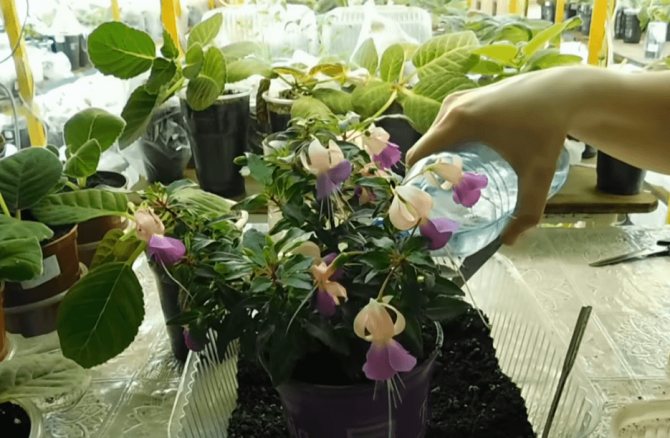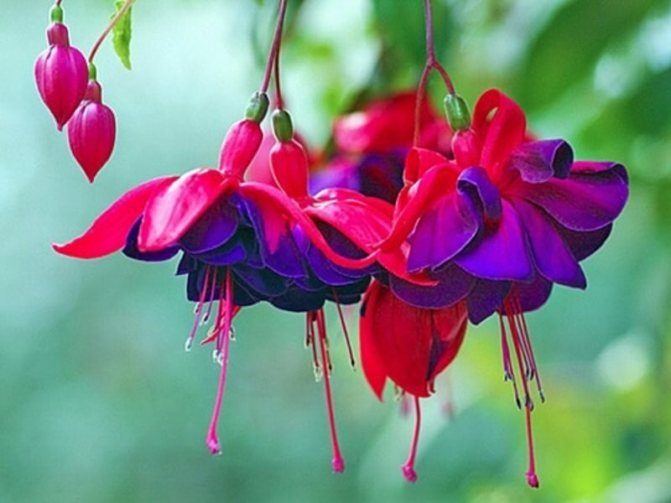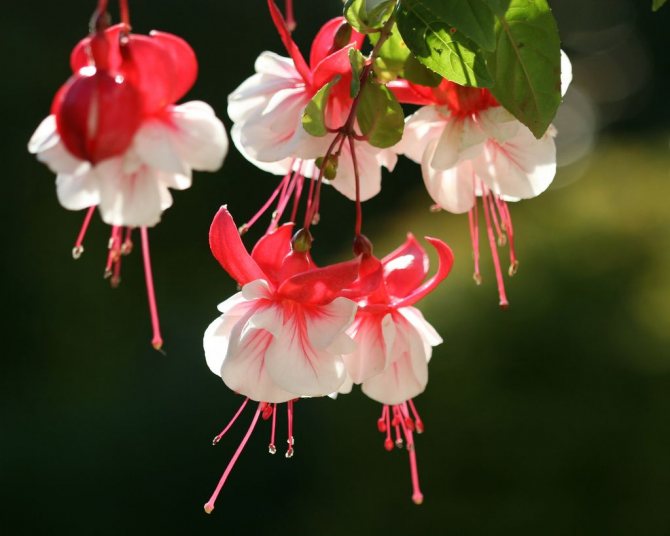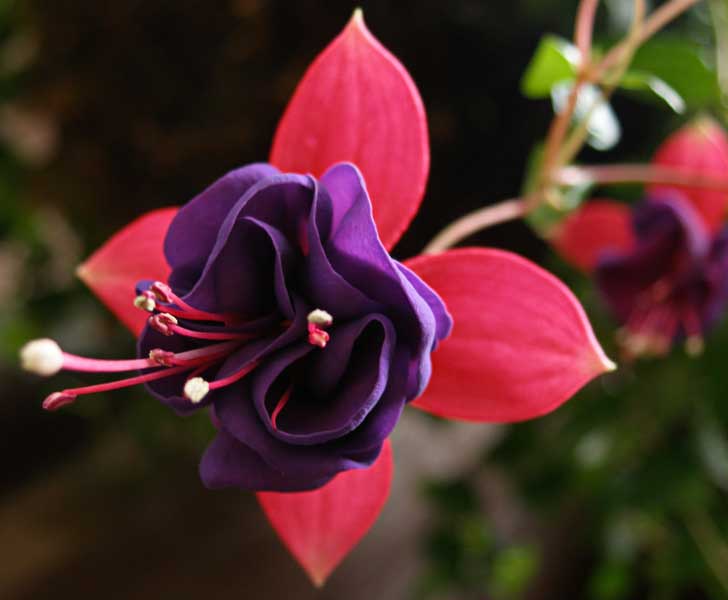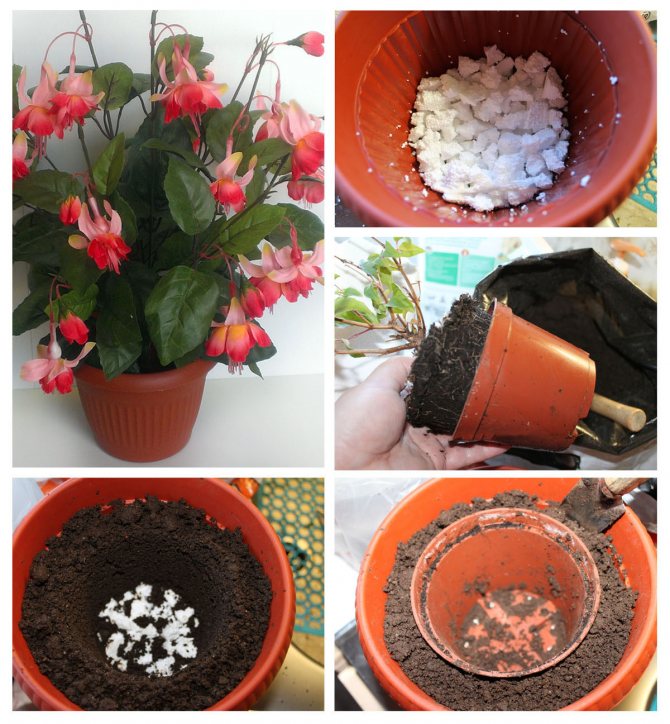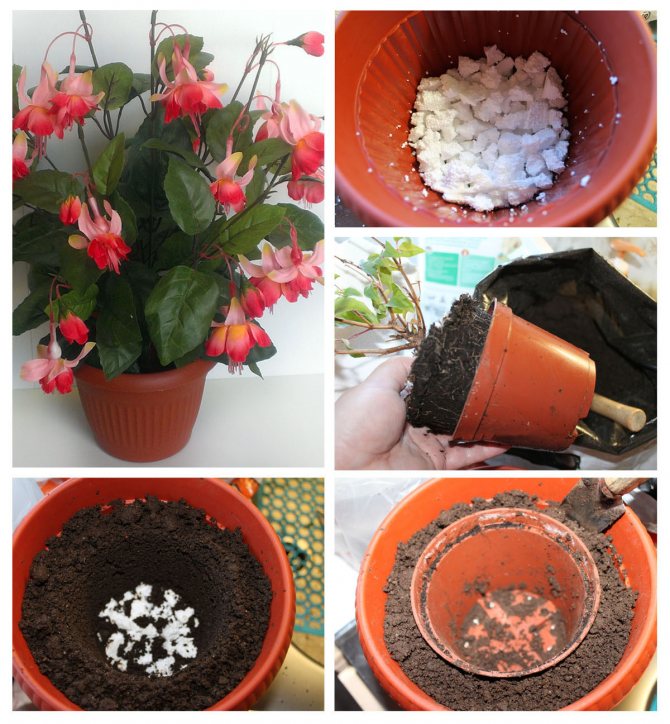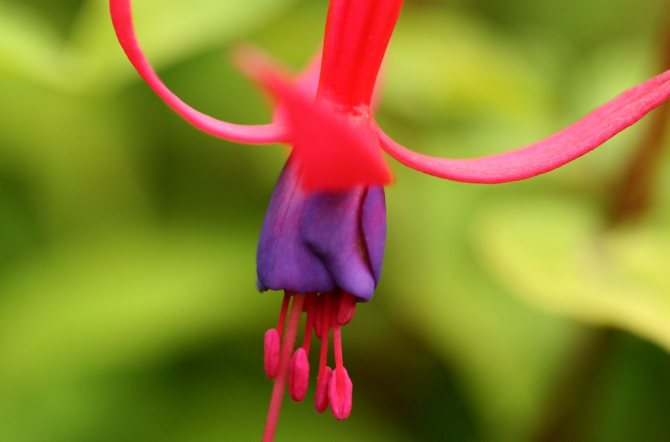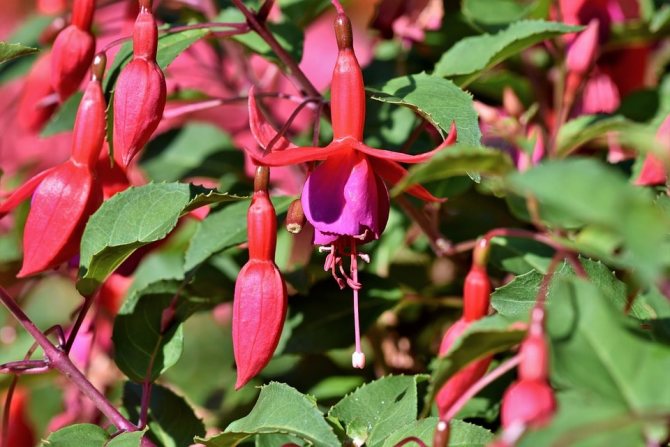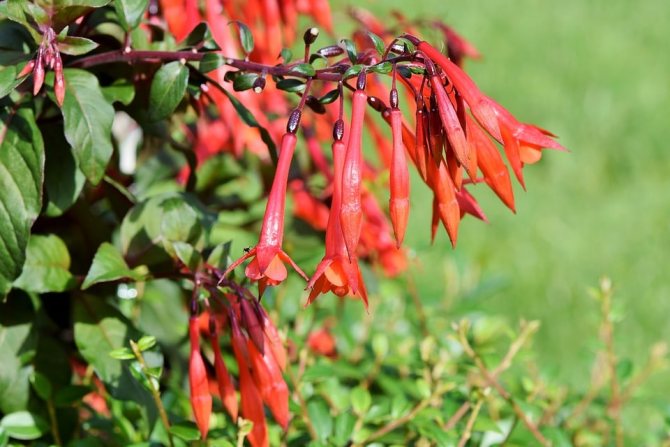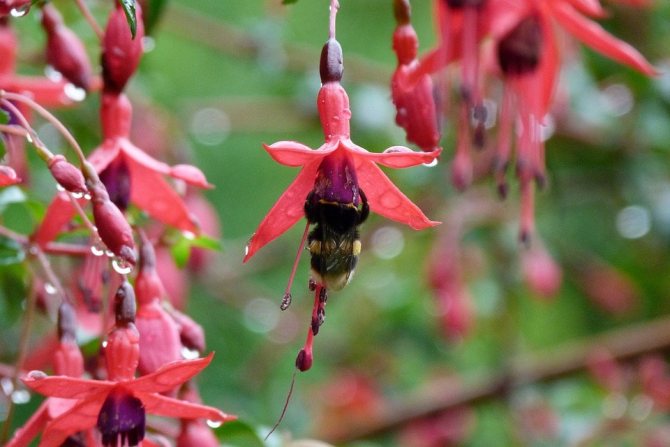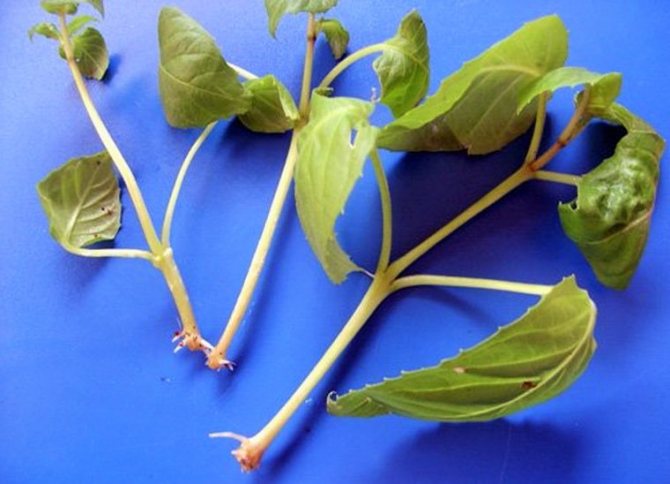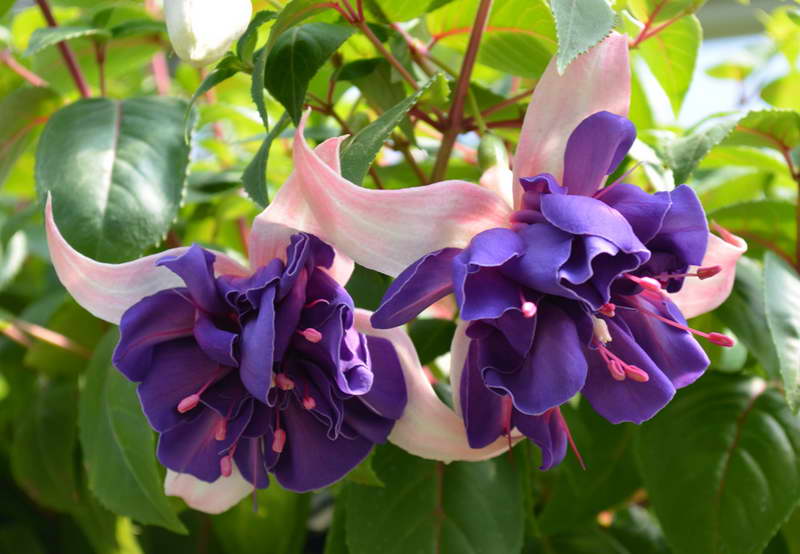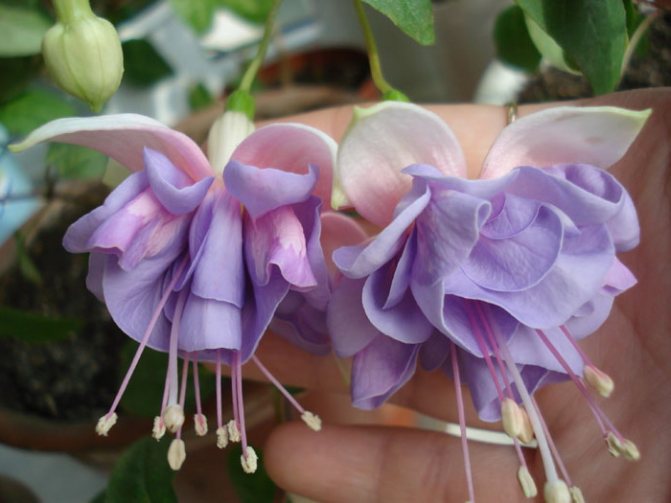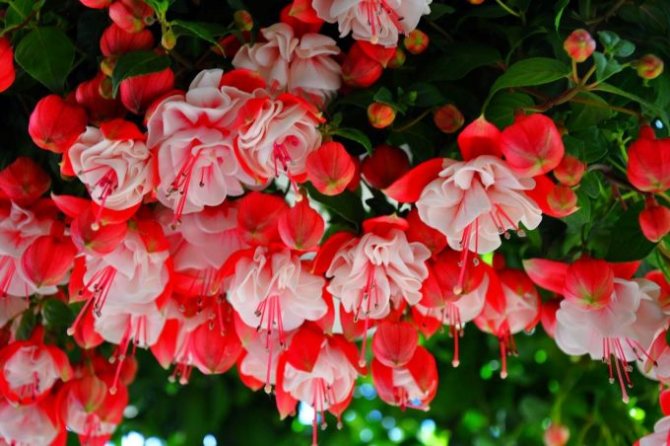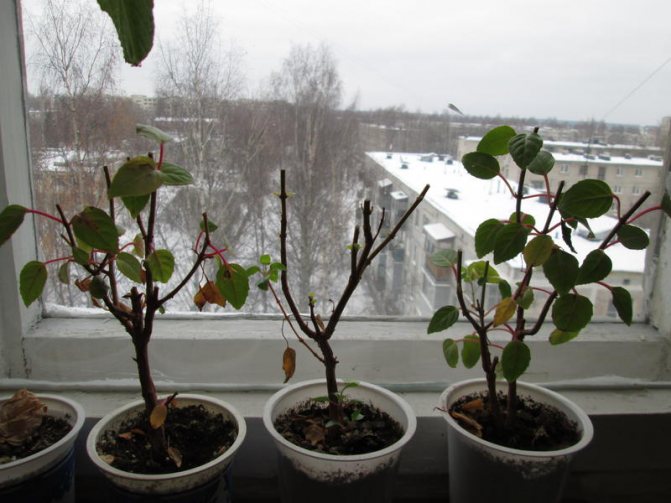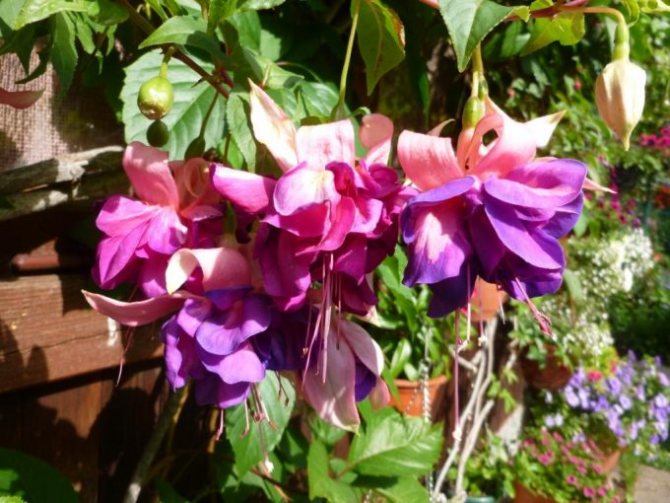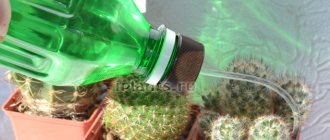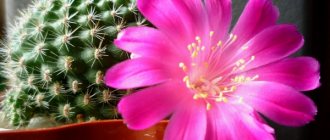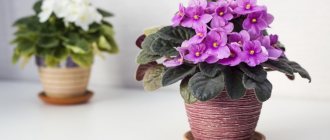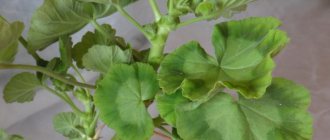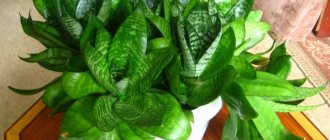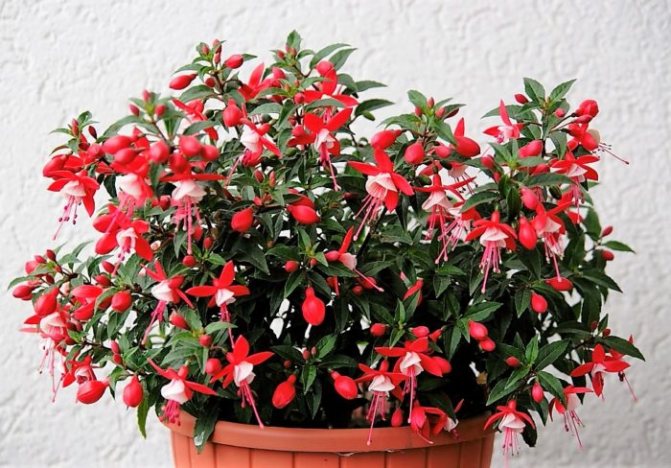
Fuchsia is a houseplant sometimes called the "Flower of the Elves". For nearly 300 years, these indoor flowers have adorned the home and office space of amateur flower growers around the world. In this article, you will read about growing and caring for fuchsia at home. The variety of color shades is simply mesmerizing. In everyday life, fuchsia is not capricious, even a novice florist can grow it at home.
Features of breeding fuchsia


The plant looks very attractive during the flowering period. The shade of the flower depends on the variety, and how abundantly the flowering itself takes place depends on the correct care.
Florists practice 3 methods of reproduction:
- seeds;
- sheet;
- by cuttings.
The first and second methods are quite time consuming and do not have a guaranteed result. Breeding with cuttings is usually easy, they root easily and begin to grow.
The cultivation of fuchsia for decorative purposes has a history of over 250 years.
Several cuttings can be cut from an adult plant without damage.
Features of seasonal care
Fuchsia is a perennial culture. Its life cycle during the year has a pronounced period of vegetation and rest. The plant cannot bloom permanently. To gain strength, she needs to provide rest. The dormant period occurs in the winter.
If in spring and summer fuchsia needs warm air, good lighting, regular feeding, abundant watering, then it needs other care for wintering. The pot should be moved to a cool place (+ 5..10 degrees). The flower does not need much light. There is no need to worry that all the leaves will fall off. In the spring, the bush will still have to make a major pruning to stimulate young shoots with peduncles. It is necessary to water the soil only after it is completely dry (3-4 times per winter).
Reproduction of fuchsia by cuttings at home
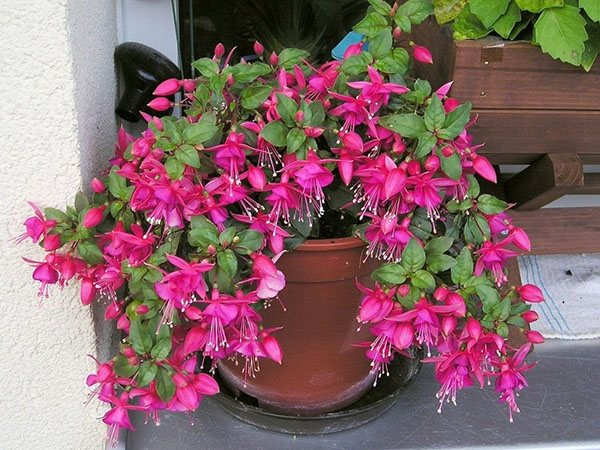

The optimal breeding time is March and February. In summer, due to the heat, rooting is more difficult and requires more effort.
Stage 1. Preparing cuttings


How to cut fuchsia? For harvesting cuttings, healthy shoots from 10 to 12 cm long are selected. They should have 4-6 paired leaves and a top. The cut is made at an angle using a sharp knife.
If the leaves on the handle are too large or there are more of them than necessary, some are cut off. When old shoots are selected for propagation, rooting will be slower.
Cutting shoots for grafting is carried out after the flowering of the parent plant is completed.
After cutting, the cuttings are dried for a quarter of an hour. After that, it is advisable to treat the cut site with a special agent that stimulates the formation of roots, for example, "Kornevin".
Stage 2. Substrate preparation
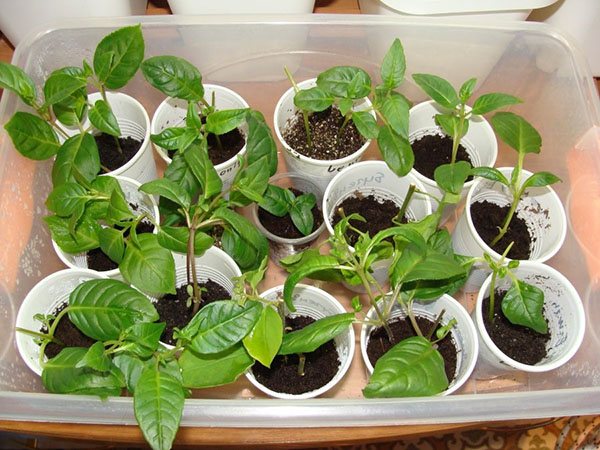

How to root fuchsia with cuttings? For this, a small container is prepared, even plastic containers and disposable cups are suitable. For the purpose of germination, you can use a variety of substrates.
This could be:
- earthen mixture;
- peat tablet;
- planting palette;
- plain water.
| P / p No. | Rooting mix | Characteristic |
| 1. | Plain water | This is the easiest way. It is enough to prepare a small vessel with purified water.Additionally, you can add a coal tablet to it, which will serve as a prevention of decay. |
| 2. | Peat tablet | It is pre-moistened with hot water for swelling. This is a very good rooting medium. |
| 3. | Earth mix | The mixture should be moist, well loosened |
| 4. | Planting palette |
- vermiculite;
- sawdust;
- sand.
How to plant fuchsia cuttings? The stalk is placed in a prepared container, slightly deepening so that the leaves on it are above the ground.
Stage 3. Creation of greenhouse conditions


After planting, the cutting needs to create a microclimate. For this, the container is covered with glass or foil. To prevent condensation from accumulating and moisture to stagnate, the glass is periodically raised.
It is important that the temperature is kept around + 25 ° C, and that bright sunshine does not fall on the plants. If the soil dries up, it must be moistened, and the water in the glass must be topped up.
After 14-20 days, when roots have appeared, new plants gradually wean from life in a greenhouse. To do this, for a while, they begin to remove the glass, gradually increasing the time spent without a greenhouse until full daylight hours.
Stage 4. Transplant
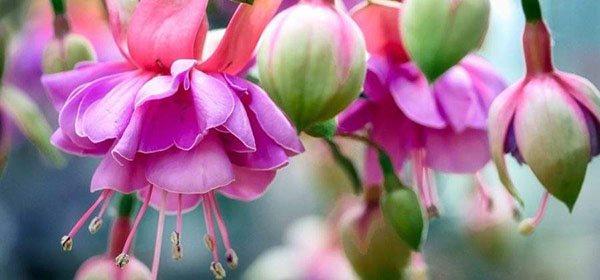

After the cutting has taken place and rooting has occurred, a new plant needs to be transplanted. Readiness for transplanting is determined by the fact that the roots have braided all the earth in a small vessel. Small flower pots can be used as a new container.
Reproduction of fuchsia by cuttings at home requires planting in soil with neutral acidity. A drain is placed at the bottom of the sampled container.
The transplanting process is traumatic for fuchsia due to the fragility of its roots. After placing in a new container, the plant is watered with warm water.
Landing


It is impossible to plant fuchsia or, even more so, a stalk immediately in a large pot. Increase the size of the pot gradually. At the beginning, the pot should not be more than 9 cm in diameter. As the roots cover the entire clod of earth, and it becomes necessary to transplant the plant, you can prepare a slightly larger pot. Place a good layer of expanded clay or other drainage material on the bottom. Add a layer of soil and plant a prepared bush or stalk.
It may be interesting: Methods for breeding Balzamin
The pot should be well filled with soil to prevent voids between the roots and the walls of the pot. To do this, gently shake the pot and tap on its walls, but, in no case, do not tamp it with your hands. For fuchsia to grow, porous soil is just as important as good drainage.
Further care
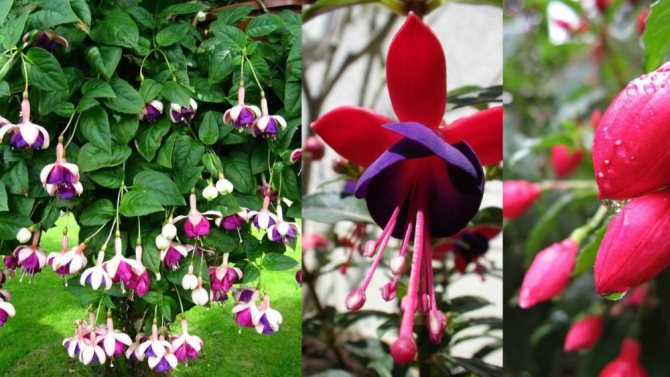

Fuchsia, which has taken root and started to grow, needs proper care.
Caring for a plant includes following these rules:
- Maintaining air temperature within the range from + 18 ° C to + 24 ° C.
- Daily spraying during the warm season.
- Good lighting.
- Moderate soil moisture when the top layer dries.
- Application of complex fertilizers as top dressing.
- Annual transplantation into new soil rich in mineral composition.
- Loosening the soil.
- During the flowering period, the plant is not rearranged or touched.
- Maintaining good air humidity - at least 50%.
- Removing flowers that have wilted.
Reproduction of fuchsia by cuttings at home is not a complicated method, which allows you to quickly get a new plant that will completely inherit all the qualities of the parent. The elegant flowers of this plant are amazing decorations for window sills, loggias, balconies and terraces.
Propagation by leaves
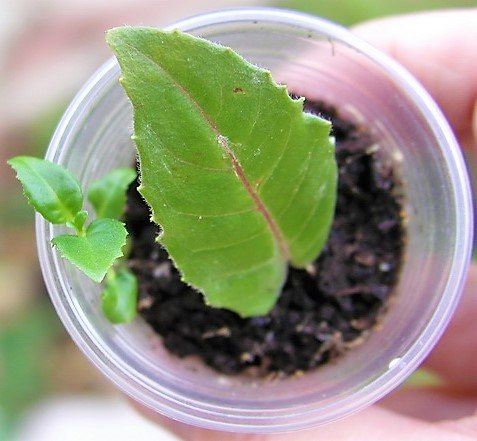

If it is not possible to cut a cuttings suitable for propagation from a fuchsia bush, you can use fuchsia leaves for this purpose. Cut a large healthy leaf together with the cuttings and dip it into wet perlite by a centimeter.In greenhouse conditions, with daily spraying, high humidity and constant temperature, a miniature rosette of leaves will begin to develop at the base of the petiole. When it is strong enough, separate it from the leaf and plant it in a separate pot of nutrient mixture (any potting pot for flowering plants will do).
The best way to breed fuchsia at home - video


The first records of fuchsias were made three centuries ago. The luxurious look of the plant touched and delighted many gardeners.
Fuchsia has not lost its attractiveness even now, but on the contrary, new hybrid varieties are appearing. It is preferred for the long process of bud formation, blooms all summer long, is also not demanding and easy to breed. In this article, we will talk about ways to breed fuchsia, caring for it and possible problems. Also watch a helpful video on the topic.
Fuchsia in winter
If the plant hibernates in a very warm place, and there is little sun, then the shoots will begin to stretch, and there will be no flowering in the new season. This will affect the decorative appearance of fuchsia, it may even cause the leaves to drop. To avoid this problem, you need to organize additional lighting or move the flower to a colder place - basement, balcony. Watering and feeding in this case is practically excluded. When spring comes, the temperature around the flower is raised gradually so that it does not come as a shock to him.
Features of plant breeding
Novice amateur flower growers are not afraid to breed a beauty on their own. In stores, they buy a ready-made flower that has at least one long shoot, and as a result, they will already get several plants. Indeed, there is nothing difficult in plant propagation. Fuchsias are bred in two ways: vegetative or seed.
The seed method is used primarily by breeders. But reproduction in a vegetative way is quite often applicable at home. Moreover, it will take about 6 months to grow a young plant from seeds, but it will bloom only in the second year of life. And you can root the shoot after a month. Also, the cuttings method retains all the characteristic properties of the mother plant.
Any part of the plant, except for flowers, is easily suitable as a starting material. It can be a large leaf, woody cuttings, but they germinate more difficult and longer. For reproduction, it is best to take a young ripe shoot..
For details on what is better to grow fuchsia yourself or purchase an adult flower in a store, as well as how best to plant a flower - by seeds or cuttings, read this article.
Seed propagation


Fuchsia seeds
Growing from seeds at home in the case of fuchsia is rarely used. This can only be done by experienced flower growers or breeders. Sometimes, for the sake of experiment, amateur flower growers also try to collect seeds from a plant and grow their own copy of fuchsia from them. If you want to try it too, we'll show you how to do it.
The procedure for obtaining fuchsia seeds is quite laborious, but interesting.
It may be interesting: Description of the species and varieties of Streptocarpus with a photo
To begin with, exclude the possibility of self-pollination of the plant or pollination by random insects. To do this, remove the anthers on the selected, not yet blossoming flower. Then, on the stigma of the pistil, on the stamens, apply the pollen of the fuchsia you want to grow. Now gently put a cloth cover on the bud or wrap it with a piece of gauze and fix it with a thread. In this form, the flower will stand for several weeks until the fruit is ripe.
In order not to spoil your work, it is better not to touch the flower during the ripening of the fruit!
When the fruit is ready, remove it from the stem with tweezers. Cut carefully and remove the seeds.Dry the seeds for a few days before planting them in the ground or storing them. It is better to plant seeds in tall containers with a lid. You need to sow seeds on a damp surface of the substrate (peat plus coarse sand). Do not cover the seeds, just press down slightly with your fingers. Close the lid and place the container in a well-lit, warm place to germinate. But, not in direct sunlight! Sowing fuchsia is desirable in early spring. The lack of lighting must be compensated for with additional lighting with fluorescent lamps. The germination temperature of the seeds should be maintained between 18 and 22 ° C. Remember to ventilate your greenhouse. If necessary, moisten the soil in the container with settled water using a fine spray bottle. Seedlings will appear in a couple of three weeks. Now the lid can be opened more often and longer - let the young bushes get used to the room conditions. Make sure that the substrate does not dry out, the lighting was diffused and for at least 12 hours. per day, the temperature should be comfortable.
After one and a half - two months, young fuchsia bushes need to be cut down. Before replanting the plants, the substrate in the container is well watered. The seedlings are taken out together with the soil at the root system, one at a time, and planted in a separate pot. Water abundantly. The land can be used purchased for flowering plants, or you can prepare it yourself from equal parts of sod and leafy soil, humus, peat and coarse sand. Remove the pots with young growth from the sunlight into the shade - let them gradually get used to the new conditions. After a couple of weeks, the pots with young fuchsias can be placed in a permanent place prepared for them. Further care consists in regular watering, good lighting, and a comfortable temperature. After a month, not earlier, you can begin to gradually feed with complex fertilizers for flowering plants. No more than once every 2 weeks. Don't forget to shape the crown of your flower. If you want it to be lush, strong, and not too tall, pinch the top off.
How to do it right?
Rooting fuchsia cuttings is easy and simple... The main thing is to adhere to certain instructions, which will allow you to get a large percentage of accepted seedlings in a short time.
The grafting method involves several stages:
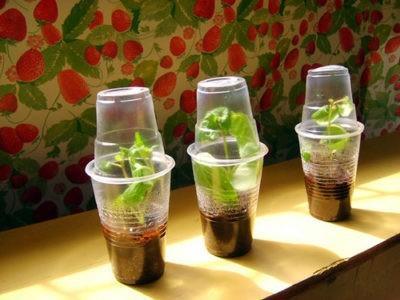

The optimum size of cuttings is 10-12 cm with the top and lateral two or three pairs of leaves. The cut is made with a sharp knife diagonally. Exclusively at the end of the flowering of fuchsia.- After the performed operation, the trimmed part should dry out within 10-15 minutes.
- We process the cut with a preparation to stimulate root formation. It can be: "Kornevin", "Zircon", "Epin", "Heteroauxin".
- The cutting should be placed in a container with the chosen medium:
- Into a plastic cup with water, after removing the lower leaves. When they come into contact with water, decay processes can develop, which eventually spread to the entire process. You need soft, filtered water. The term for root formation is on average 2 weeks.
- Can be planted in a planting palette filled with substrate (sand, sawdust, vermiculite). The filler must be pre-moistened.
- A peat tablet is also suitable. It should be saturated with hot water, as it swells faster. In a peat tablet, plants immediately begin to actively develop, 99% of the cuttings take root safely.
- Plant immediately in a moist, loose earthy mixture. The soil should include most of the sand, vermiculite.
- Create a greenhouse effect. Cover the containers with glass, transparent foil. Such a greenhouse requires regular ventilation and removal of condensate.
- Place the cutting in a sunny spot where it is light but not too hot. The air temperature inside the greenhouse should not exceed + 25 ° С.
- As needed, the stalk is moistened, preventing the soil from drying out.
- After the roots appear, the process requires a transplant. A long delay with this, in the future, can negatively affect the plant.
- Small plastic cups or small pots are great containers.
- For transplanting, a specially prepared soil with a neutral pH is chosen. Drainage is laid at the bottom of the flowerpot. It is worth lowering the plant into the ground carefully, the roots are very fragile so as not to break. Then fuchsia should be watered with settled warm water.
- Do not forget to stick markers on the cups indicating the variety.
- The plant will fully take root when it grows.
Watch a video about fuchsia cuttings:
Diseases and pests
Healthy fuchsia is distinguished by beautiful, richly colored leaves. As soon as you notice them drying out or staining, it's worth worrying: the problems that have arisen indicate diseases or parasites.
- Powdery spots indicate powdery mildew. This problem occurs when there is an excessive intake of water and moisture. To get rid of the disease, the flower is treated with Topaz or Fundazol.
- Dry or yellowed leaves indicate chlorosis. The disease occurs due to excessive moisture of the plant in the winter. In the presence of yellowing veins, the problem is a lack of magnesium. For treatment, watering with pinkish potassium permanganate is used.
- The underside of the leaf, covered with dry brown spots, indicates a severe fuchsia infection. The affected greens must be urgently removed, and the rest of them must be treated with Bordeaux liquid three times a day, and repeat after 10 days.
- Sluggish leaves indicate a lack of light or nutrient intake.
Parasites are often the cause of the disease. White fly larvae are found at the bottom of the leaves, as they drink their juice and secrete their harmful substances. This causes yellowing and death of the leaves. To kill pests, you need to process fuchsia "Aktellik" or "Angara".
Follow-up care
In order for the plant to feel comfortable, it is necessary to adhere to the basic rules:
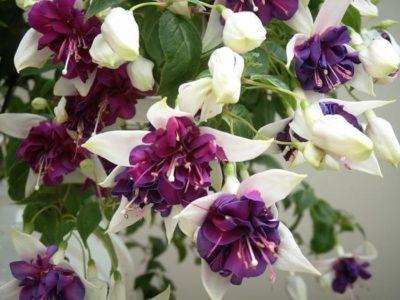

The optimal temperature regime should be at + 18-24 ° С. At a higher air temperature, the flower sheds leaves, buds, and begins to dry out.- Fuchsia requires spraying 1-2 times a day. In the cold season, such a procedure should not be carried out.
- The plant needs sunlight, however, not scorching. It is better for a flower to choose well-lit window sills in the house. It is not recommended to move and transfer the pot during flowering, otherwise the fuchsia may stop flowering. Outdoors, it grows best in partial shade.
- Moisture is moderate as the top layer dries. In the heat, watering is carried out daily.
- Be sure to feed the flower with complex fertilizers. During the flowering period, choose preparations with a high content of potassium and phosphorus. Fertilize every week. The exception is the winter period. Street fuchsia can be fed with organic fertilizers.
- Every year, in the spring, fuchsia requires transplanting into soil enriched with minerals (you can find out how to transplant fuchsia here).
- As necessary, you should pick off dried flowers, loosen the soil, spray, remove dust from the foliage, and inspect the plant for pests.
Watch a video about taking care of fuchsia at home:
Read more about the rules for caring for fuchsia at home here, and from this article you will learn about the nuances of growing a flower in the garden.
Fuchsia winter care
Fuchsia is a perennial plant. It cannot grow and bloom from year to year without interruption. To replenish her vitality, she needs rest - wintering. But home care is as necessary in winter as it is at other times of the year. Fuchsia is usually at rest in winter. From a warm, light room, it must be transferred to a dark and cool one. For example, in a basement or garage with a temperature of 5 to 15 ° C.Lighting in the winter fuchsia is not needed. The indoor flower should be watered a couple of times a month - he does not like very dry soil even during hibernation. Let him stay there until the end of January. Don't worry about the leaves dropping off - you will still remove almost all of the shoots. By spring, new, young ones will grow.
It may be interesting: Complete classification of species and varieties of Violets (Saintpaulia)
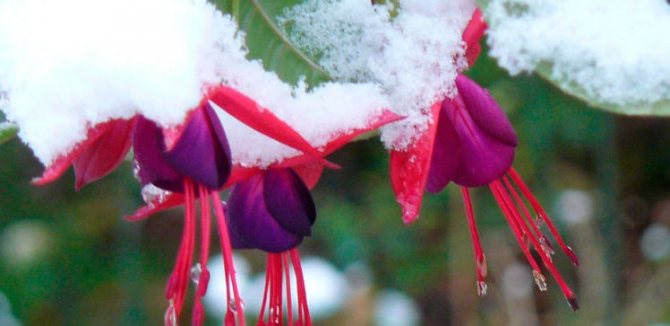

If you have a glazed and insulated balcony, where the temperature does not drop to minus values, the fuchsia pot can also overwinter on the balcony. Only here she will not be able to fully rest, since the processes of her development will continue in the light. The flower will need to be looked after and watered regularly, but not abundantly. Dry leaves and shoots must be cut off so as not to provoke the development of diseases. In winter, a weakened plant can attract the attention of pests. It should be treated with an insecticide at least once during the autumn-winter season.
If your fuchsia is in the room in winter, it will survive, but by the end of winter it will lose all its attractiveness and take on a deplorable look. In this case, cut the plant back 2/3 of its length and remove any dead branches. Move the flower away from the heaters - on a table or shelf. Monitor the humidity of the surrounding air. If necessary, and in winter it is definitely necessary, increase the humidity in the room by spraying the plant with warm water. Ventilate the area as often as possible. Place wide containers filled with water next to the flower. Regularly, but not too abundantly, water the soil with settled water, sometimes adding potassium permanganate. Feed the flower with a complex fertilizer for flowering plants once a month. When these conditions are met, your fuchsia will come to life, new shoots will appear. It can even bloom in winter. But do not hope that in the spring it will quickly regain its shape and delight you with an unprecedented flowering.
Possible diseases
Fuchsias are considered non-demanding plants.... However, trouble with a flower occurs as a result of improper care. Especially harmful to the plant is excess moisture, which leads to decay of the root system, disruption in its work, then the negative process spreads to the foliage. The leaves also begin to dry and rot. In such an environment, gray rot feels great. To combat this phenomenon, use special solutions of fungicides, preparations containing copper, as well as 1% Bordeaux liquid.
Another disease dangerous for fuchsia is rust. The foliage below is covered with yellowish-orange spots. In the early stages of the disease, the lower leaves fall, and subsequently, the upper ones.
No less problems can be caused by pests: aphids, whiteflies, spider mites... They are located on the lower part of the leaf, feeding on the sap of the plant. In this case, the foliage turns yellow, dries, falls off. The most effective means to combat them is insecticide preparations.
Pests
Whitefly
In hot dry weather, pests can settle on fuchsia bushes. The most common parasites for this flower are the whitefly and spider mite. You will see a whitefly if you shake your bush - a lot of tiny white moths will fly in all directions. The larvae and eggs of the pest will remain on the leaves. This is a very dangerous pest. It multiplies quickly and is difficult to hatch. You can identify a spider mite by the cobweb that appears on the undersides of the leaves.
If this problem arises, it will have to be solved with the help of folk remedies or chemicals, insecticides. It is necessary to spray the affected plants several times, with intervals of 5 - 7 days, until the fuchsia is completely rid of the sucking insects.
Watch your plants, regularly inspect them for disease and pest damage, and take action in time.
Video: care for fuchsia
Agrotechnics
Fuchsia is a universal culture. In the process of growing, it can be given any shape:
- bush;
- standard;
- pyramidal;
- ampelous;
- spreading;
- climbing;
- can be grown as bonsai.
Different varieties of fuchsia can bloom at different times and have a variety of flower colors. Thus, you can collect a whole series of varieties of culture. This will make it possible to ensure the flowering of fuchsia from early spring to late autumn. And it blooms profusely and for a long time.
The most popular varieties:
- Winston Churchill;
- Bon Accord.
- Brutus.
- Cystic flower:
- Svoili Yellow;
- Leverkusen.
The plant prefers bright diffused lighting (in the morning), partial shade (at noon, in the afternoon until the evening). It is best to settle fuchsia on the windowsills of the east or north windows. In summer, you can take it out onto the balcony, into the yard. Place it in a place where the sun's rays are only in the morning. In winter, you need to provide the flower with additional illumination - up to 11 - 12 hours / day. Phyto lamps or fluorescent lights are used.
Attention! To prevent fuchsia from getting burned, it is necessary to cover it with a light cloth or paper.
Fuchsia loves coolness. Comfortable temperature in summer - no more than + 20 degrees, in winter +15 degrees.
The flower grows well on light, breathable soils (peat can be added). There should be no stagnant water.
The plant does not tolerate excessively dry air. From this, leaves and buds may turn yellow, fall off. The preferred humidity is 50-60%. Therefore, you should regularly spray the plant with a spray bottle in the summer, especially in the heat, in the morning or in the evening. The water should be separated, at room temperature. You can place a wide container filled with water next to the flower, or put a pot of fuchsia on wet pebbles or expanded clay, poured into a pallet.
Important! Experienced flower growers do not recommend rearranging fuchsia from one place to another, as well as periodically turning it to the rays of the sun in different directions. The culture does not like this, it can throw off all the buds.
Water the plant regularly, in moderation, after the top layer of the earth dries out (every 3-4 days). This is especially required for fuchsia during the summer flowering period. When late autumn comes, watering is reduced. In winter, irrigate no more than 1-2 times a month.
In March, they begin to feed the flower (every 10 days). Use means for flowering indoor plants. In winter, no top dressing is added.
Pruning is carried out 2 times a year (early October, early January). The dormant period for the plant begins in late autumn (October), lasts all winter.
Fuchsia is transplanted in the spring. The culture is propagated by seeds, cuttings.
The plant can be affected by powdery mildew, rust, root rot, spider mites, whitefly, and aphids.
How to propagate fuchsia at home with seeds
Trimming and pinching


Fuchsia flowers appear on young shoots. In order for such shoots to become more, the plant should be regularly cut off, and young shoots should be pinched. Pinching is a very effective method to make fuchsia bloom more profusely. With the help of nips, they form the necessary shape, give the crown the appearance of a ball, bush or miniature bonsai tree.
Fuchsia, depending on the variety, grows in height up to three meters or more. It is difficult and impractical to grow such a giant indoors. If you pinch the plant in time, it will form into a strong and beautiful bush.
It is necessary to cut indoor fuchsia twice a year: in the fall, at the end of the mass flowering of the flower (October), and in the winter (at the beginning of January).


Fuchsia tree
During the first, autumn, pruning, you will remove all faded fuchsia twigs at a height of 2 cm from the dormant buds.Carefully inspect each branch for the presence of pests, remove excess seed pods and outdated flower stalks. If insect pests are found, cut off the heavily damaged parts of the flower and treat the entire plant with an insecticide.
Do the second pruning at the beginning of January for the final formation of the plant crown. If the fuchsia has wintered in the basement or garage, the plant has already been pruned in the fall. In the spring, it remains to remove dry shoots and leaves from it.
If the plant has been in the room all winter, it must be cut off. Use a clean pruning shears or garden shears to remove any long and thin shoots, as they will be of little use. They will not bloom magnificently, and your bush will not become more beautiful from them.


Fuchsia bonsai
If the plant is pruned periodically, it will grow in breadth instead of in height. It is also better to cut off stiff old shoots, since they consume nutrients, and there are almost no flowers on them. All flowers bloom only on young shoots. A strong and beautiful bush will soon form.
If you decide to form a bonsai from fuchsia, then leave only one shoot or, conversely, several such shoots that can be twisted together so that they serve as the trunk of your tree. The tops must be pinched to form a lush crown on the bonsai.
What is the best way to pinch fuchsia so as not to harm its beauty and decorativeness?
If you want to form a tree from fuchsia, pinching should be done in winter, when the life processes of the plant slow down. Remove excess shoots, leave a few on the central stem. In the spring, see what happened. If the crown of the flower has not yet formed as you would like, it is pruned again in the spring.
You can cut the plant to the very stump. In this case, the fuchsia will sleep longer and bloom later, but a wide bush will form.


Fuchsia bush
If the shoots are cut only a third, the fuchsia will turn into a tree and can take up a lot of space.
Shoots that grow in the place of old branches, as they grow back, pinch a couple of times. Fuchsia will then turn into a lush beauty and delight you with abundant flowering.
If young twigs are pinched over the third pair of leaves, tillering will intensify. To enhance the tillering effect, the grown branches need to be pinched again, but now near the second pair of leaves.
You decide what you will grow from fuchsia - a bush or a tree!
Keep in mind that before the fuchsia bloom, it takes two months for the formation and development of buds. Fuchsias with small, simple flowers bloom earlier than plants with giant inflorescences and large double flowers.
Fuchsia propagation
Now about how fuchsia reproduces. For cultivation of a culture, two methods are used: by seeds, cuttings (vegetatively).
The first option is pretty troublesome. It is used mainly by breeders, and the plant practically does not retain the varietal qualities of the parent bush. In this case, you need to pollinate the seed yourself, prevent self-pollination of the flower, pollination of fuchsia by insects. You can also purchase seed from the store.
How to propagate fuchsia at home with seeds
- In February, achenes are sown in a light, nutritious soil mixture. They are laid out on top of a wet soil, previously treated with a solution of potassium permanganate, slightly pressed against it.
- Cover the containers with foil. They are placed in a warm, bright place. However, you should not allow direct sunlight, there should be diffused light. The required temperature is +22 degrees, for a cold-resistant variety, +18 degrees is enough.
- Shelters are removed 1-2 times a day to ventilate the seedlings. Spray the soil with water periodically.
- When the seedlings hatch (after 2-3 weeks), raise the film more often, then remove it completely.After two or three leaves appear, the seedlings dive into different pots. After 1-2 months, they are seated in more spacious containers.
- Young shoots are sprayed once every two weeks, fertilized with mineral compounds.
Note! By propagating fuchsia in this way, you can grow a young seedling in 5 months. And the bush will bloom only after a year.
Fuchsia: propagation by cuttings at home
According to experienced flower growers, fuchsia can be cut almost all year round. However, the best time for this, of course, is spring.
Step-by-step instructions for cutting fuchsia in water:
- In the spring (March, you can start in February), before propagating fuchsia, healthy young petioles 10-20 cm long are selected. They are cut from the shoots growing on the apical branches. They must have 2-3 internodes.
- With a sharp knife, make an oblique cut (angle of 45 degrees) under the lower leaves. Then they are removed. Leave the top leaves, cutting off the leaf plates in half.
- The top of the appendix is cut off in the same way. You can use old shoots, but then the rooting process will take longer.
- The process is allowed to dry for 10-15 minutes. A trim, its lower part is powdered with Kornevin (you can take Epin, Zircon, Sodium Humate, Heteroauxin).
- The petioles are placed in a glass jar filled with settled water. Cover the top with a plastic bag or a transparent plastic glass, half a plastic bottle.
- After 5-14 days, roots should appear. There is no need to wait for them to become long. Now the cuttings must be planted in separate small pots (their diameter, height - 9 cm). It is necessary to disinfect the earth in advance with a solution of potassium permanganate.
- Prepare the soil well in advance. It is necessary to mix in equal parts leaf, turf soil, sand, humus. Another composition is also used: peat, perlite, vermiculite (10%), sphagnum moss (a little). You can buy ready-made primer in the store.
Transfer
We take out fuchsia from an old pot
Fuchsia is a fast growing plant. Therefore, it must be regularly transplanted into a pot of a suitable size, which is 3-4 cm larger than the previous one. It is best to do this every spring, during the beginning of the awakening and growth of the flower.
It is better to take a ceramic pot so that it protects the root system of the plant from overheating in the summer heat. Don't forget about drainage. 2 - 3 cm of expanded clay or pebbles at the bottom of the pot will protect the roots of the plant from decay. It is better to take a commercial potting soil mixture for flowering houseplants as a substrate.
You can also independently prepare the soil for transplanting fuchsia. To do this, mix in equal parts leafy soil, turf soil, humus, peat and coarse river sand. Transplant by the transshipment method: pour some prepared soil into the pot on the drainage layer, then carefully remove the fuchsia from the old pot and place it in a new pot along with a lump of earth. Fill the voids on the sides with potting soil.
After transplanting, place the fuchsia on a shelf with diffused lighting. Cut off the stems one third of the length. Spray the leaves and pour the standing water over the substrate until excess water appears in the pan. After a few minutes, drain excess moisture from the pallet.
After transplanting, no additional feeding is needed for a month!
Now wait a couple of months - abundant flowering of fuchsia is guaranteed to you!
Tips for growing a plant from cuttings
- In early autumn, you can prepare the stalks to preserve the plant in the winter. Several shoots are cut from mature, healthy bushes (length 15-20 cm).
- They are stored in containers filled with soil in garages, basements, or cuttings are kept on the lower shelf of the refrigerator, placed in a bag with sawdust.
- Before the onset of spring, they are taken out, treated with a manganese solution, and placed in water.
It is not difficult to grow fuchsia from a cutting. You just need to figure out how to propagate fuchsia and strictly follow all the recommendations.
In the first method, diseased, dried, frozen shoots are removed, in the second case, they get rid of excess, densely growing and irregular branches that interfere with the development of the plant. The latter type of pruning is carried out in order to give the culture an aesthetic appearance by forming a crown.
Sanitary pruning is carried out at any time of the year, thinning - from mid-spring and during the summer, shaping - in early spring, 2-3 times in summer, at the end of autumn.
Pests
Periodically, viburnum can be overcome by pests that adversely affect the plant and negatively affect the quality and quantity of the crop.
When fighting these insects, you need to shake them off the shoots every morning on a film spread under the crown. Then get rid of them.
Purchased complex action products cope with unwanted "guests" perfectly: fufanon, lightning, kinmix, karbofos, fitoverm, green soap.
Diseases
Viburnum viburnum is susceptible to the following diseases: powdery mildew, gray and fruit rot, yellowing, mosaicism and leaf spot can also be observed.
Struggling with an ailment, you need to find out the cause of its appearance, purchasing drugs for treatment, focus on a specific type of disease.
Types and varieties of fuchsia for growing at home
The varietal variety of "Japanese lanterns" is huge. These can be double and semi-double hybrids, which differ not only in shades of flowers, but also in the number of corolla petals. When choosing a suitable variety for home growing, you need to focus on the ability to create suitable conditions for it.
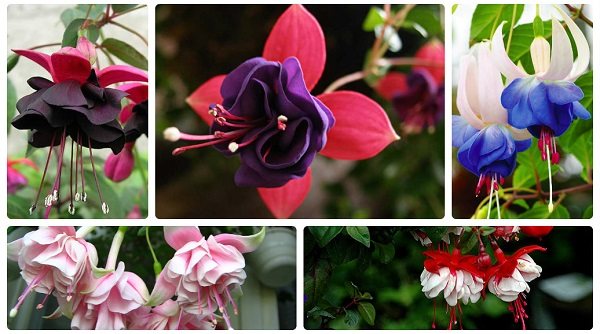

Shiny (fulgens)
The plant is native to Mexico with a height of 1-2 m. It has branched stems, large leaves, heart-shaped or ovoid, up to 20 cm long. Inflorescences are racemose, formed at the tops of the shoots. The flowers are pale red with long petals. The shiny fuchsia fruit is edible.
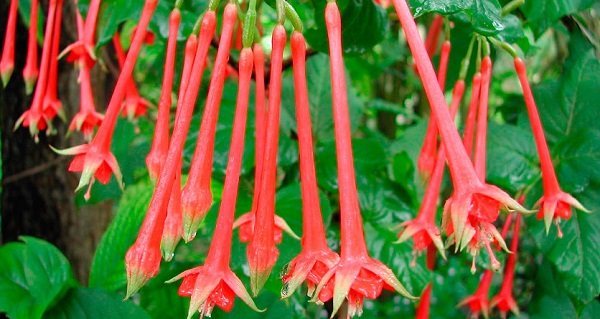

Bolivian
The species grows in the mountainous regions of Argentina, Bolivia. It is a bush about 1 m high. The leaves are elliptical with pointed tops and jagged edges 15 cm long. It blooms in the first half of spring. Inflorescences racemose, dark red flowers 1 cm in diameter with a long corolla.
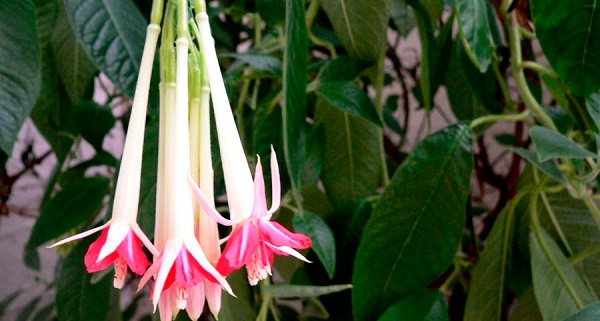

Magellanic (magellanica)
It is also called multi-colored. It is a shrub 2-5 m high. The stems are purple, slightly pubescent. Leaves are lanceolate-ovate with a serrated edge 5 cm long. The flowers are axillary, can be single or collected in several pieces. The corolla is pale red, the petals are lilac-blue. Blooms all summer.
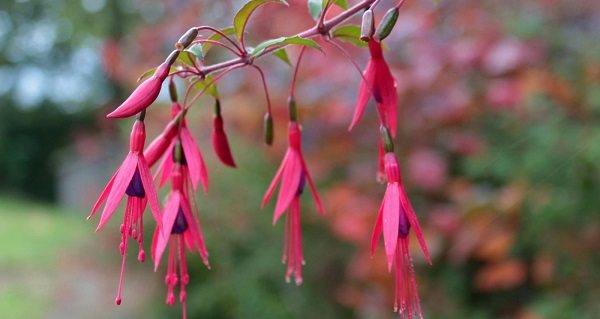

Thyroid (corymbiflora)
The species is found on the slopes of the Peruvian and Ecuadorian mountains. In nature, the shoots grow up to 5 m. The leaves are oval, whole-edged up to 17 cm long. The flowers are purple, the calyx tube is red.
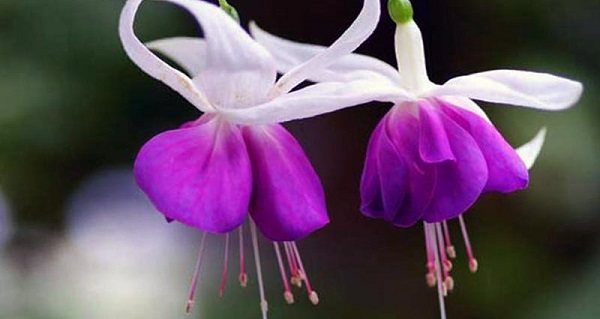

For beginner florists, the following varieties are suitable:
- Andromeda;
- Anabel;
- Hollys Beauty;
- Blue frills.
They are the most unpretentious, do not require a lot of time and attention.
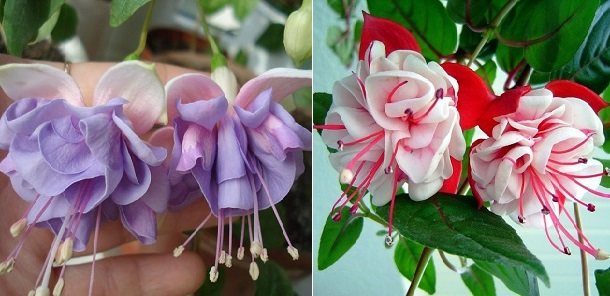

Interesting features of viburnum
- Almost all the fruits of viburnum varieties are edible, tart to the taste, mostly bitter, but there are also sweet ones.
- The viburnum harvest has beneficial properties: it is rich in phosphorus, potassium, magnesium, iron, copper, manganese, iodine, vitamins A and C.
- Berries have a lot of applications: they make jams, bake pies, use them to make tea, treat themselves, make all kinds of cosmetic masks and scrubs, make alcoholic beverages.
- Almost all the components of viburnum (bark, leaves, flowers, berries) are used for medicinal purposes.
- The shape of the crown can be easily changed, since these shrubs tolerate pruning well.
- Plant varieties are often used for the benefit of humans: they are planted along roads to create snow-collecting areas; for strengthening the soil in mountain areas; to attract birds to forests, planting different species of viburnum in plantings; and also planted in public places (often it is a viburnum of the Sargent Onondaga variety).
Having decided to decorate your garden with viburnum shrubs, you can get lost in the variety of varieties.Which variety to choose: dwarf or tall, with ordinary red fruits or with a more original color, with a round crown or a more spreading version? But even having opted for the first variety that comes across, it will be possible to settle an excellent decorative ornament on your site, which also has a lot of useful properties and does not require significant efforts during cultivation.
Why does fuchsia not bloom


Why fuchsia does not bloom what to do How to care for fuchsia
A healthy plant may refuse to bloom, and then you need to look for the reasons for this phenomenon. They may be different, but the root is the same - wrong care. The main problems are of the following nature:
- the plant wintered in the warmth;
- there are practically no nutrients left in the soil;
- very frequent watering;
- the pot is not the right size;
- very little light, the lack of which inhibits active growth and bud formation.
To ensure the flowering of fuchsia, these problems must be eliminated. If the wintering was warm, after it the shoots are strongly cut off. If the pot is not suitable, arrange a flower transplant. The roots should not be protruding from the pot and should not feel excessive space, so the fuchsia will begin to form green shoots and will not bloom.
Pruning fuchsia for the winter
When caring for fuchsia, such a spreading plant must be cut from time to time. This is done to rejuvenate the bush and to improve its appearance. It has been noticed that pruning fuchsia stimulates profuse flowering. It is recommended to cut off old stems completely. Young - partially trimmed and pinched. Such pruning is performed when the plant is actively growing green mass.
You can also form a tree from a fuchsia bush. For this, a support is constructed for the main stem, and all other stems are cut off. The upper part of the stem is also cut off, as a result of which the plant will form side branches. Subsequently, the desired crown can be formed from them by cutting the branches to the required length.
Fuchsias, with proper maintenance, can delight for a very long time with their lush forms and abundant flowering. Treelike fuchsias in this sense are real long-livers - some species can live for more than fifty years. Shrub and ampelous forms have a shorter lifespan, moreover, with age, their stems lose their attractiveness; that is why it is customary to remove old shoots on such plants in order to rejuvenate the bush.
Pruning fuchsias is a profitable activity in the sense that the cut stems can be used as cuttings for propagation. It turns out a kind of "waste-free production".
How to grow a flower: step by step instructions
- You need to choose a pot, soil and fertilizer. To get started, stop at a small pot made of ceramic, about 10x10 in size.
- Pick up the soil - you can buy a universal mixture by adding a little sand to it, or mix your own turf, peat and sand in a ratio of 3: 2: 1.
- The first feeding also needs to be introduced simple - the soil with the addition of nitrogen is perfect for starting flower care.
Read more about the rules for growing room and garden fuchsia here.
Seed preparation and germination
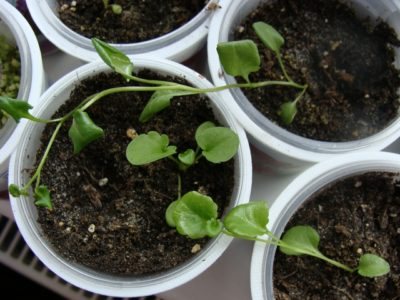

Fuchsia seeds can be purchased at any gardening store. Sowing seeds is best in February..
Before sowing, the soil must be moistened with a solution of potassium permanganate, from a spray bottle.
When planting, seeds do not need to be buried deep in the ground - you just need to slightly press the seed in: the plant needs light for good germination.
Further it is necessary:
- cover the pot with transparent cellophane or film;
- put on the windowsill;
- monitor temperature and moisture.
If all actions are performed correctly, already after 3-4 weeks the first small shoots can be expected to appear... During this period, it is very important to lift the cellophane, removing the concentrate.After germination, it is recommended to remove the cellophane for a longer time to adapt the plant to indoor conditions.
Care
When the soil dries up, you need to moisten it with a spray bottle, spraying the soil around the sprout. Water for irrigation should be separated, at room temperature.
The ambient temperature for proper growth should be in the region of 18-22 ° C.
Constant lighting should provide the sprouts with light well, while it is better to protect them from direct sunlight. The best thing is to put the pot on the windowsill.
Sprouted sprouts after the appearance of the first leaves should be periodically sprayed a small amount of water, you can use the same one that is used for irrigation. Spraying 1-2 times a week will provide the required level of humidity.
When to plant seeds
It is believed that it is best to plant fuchsia in the spring: the optimal time for planting fuchsia seeds is March or April.
However, this is not a formula: there is information about a successful January planting. Moreover, by March, the height of the bushes reaches ten or fifteen centimeters.
Note! Having outlined the month when it is planned to plant seeds, it is worth considering the lunar phases. They are recorded in the lunar calendars. You need to navigate for two weeks during the growing moon (from new moon to full moon) - the aboveground parts of plants planted in this time period will be as dense and strong as possible.
Care
Breeding roses with cuttings at home
After the stalks have been planted and greenhouse conditions have been created for them, they must be ventilated every day (1-2 times). Moisten the soil periodically, preventing the earthen coma from drying out.
When the plant gets stronger, it is transplanted into a more spacious pot (preferably ceramic, this will protect the culture from overheating in summer).
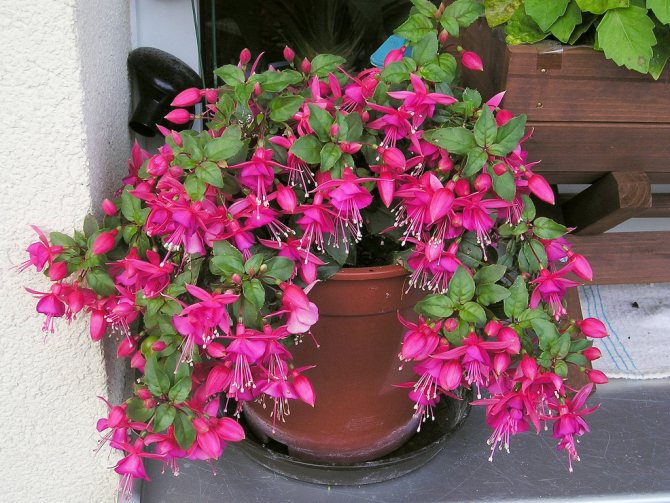

The plants are fed during the flowering period with potassium-phosphorus substances. As needed, they cut off dried flowers, form a crown, loosen the soil, spray a bush. Fuchsia is transplanted in the spring.
Benefits of grafting
This is the best way to propagate fuchsia at home. This is due to the fact that the process is guaranteed to transfer features from the parent plant, as well as to the relative ease of use.
How to plant fuchsia cuttings
Forming fuchsia at home and pruning
When the cutting has been rooted, it needs to be transplanted. This will require a soil of a certain composition. It should have a neutral pH. A drainage layer is placed on the bottom of the flowerpot where fuchsia is transplanted.
If you plant fuchsia, you need to be very gentle with the plant's root system. This is due to the fact that it is fragile and can easily break. After planting, fuchsia is watered with settled warm water.
Since it is not difficult to root fuchsia with cuttings, the method is available to everyone. The main thing is not to forget to leave a label on the pot with a description of the plant variety. Rooting will end when the fuchsia begins to actively grow.
Note! It is necessary to decide in advance on a permanent place for growing a flower. He does not tolerate movement well, so it is advisable to minimize them.
For the propagation of fuchsia, it is important to choose the right pot in which it will grow. For home use, those with a diameter of 18-20 cm are often accepted. Shallow containers made of clay are best suited. This material is not capable of overheating.
Varieties
Fuchsia has many varieties and varieties. They differ from each other in the shape of the leaves, the shade of the inflorescences, the flowering time, etc.


Among the most popular plant varieties:
- Deep Purple. The branches of this variety of fuchsia tilt downward as they grow. Inflorescences are large, dark purple in color. To the touch - semi-double.
- Bella Rozella has lush flowers that shimmer with pink hues.
- Fuchsia Bella Rozella Checherboard has straight, upward-growing stems.The flowers are mostly red with a slight addition of white.
- Leonberg has large pink flowers with bracts that differ in shade.
- Brutus is a bush fuchsia with bright scarlet inflorescences.
Fuchsia is a beautiful and abundantly flowering plant that will decorate both an apartment and an office. The abundance of colors will satisfy even the most sophisticated taste. At the same time, it is easy to care for fuchsia. These advantages allow this plant to confidently hold a leading position in the hearts of flower growers.
How to get seeds
The continuity of the existence of an exotic plant in our conditions can be ensured in three ways:
- obtaining from seeds;
- reproduction by petioles;
- growing from a leaf.


Those gardeners who want to know in advance what will grow from a fuchsia seedprefer store-bought seed.
But amateur breeders are often attracted by the desire to obtain an interesting hybrid with artificial pollination.
The selected plant, from which seeds are needed, must be deprived of the possibility of self-pollination. Therefore, all anthers from the stamens of flowering buds must be carefully cut off. Then the pollen from the flower of another plant is applied to the pistils with a squirrel brush for painting.
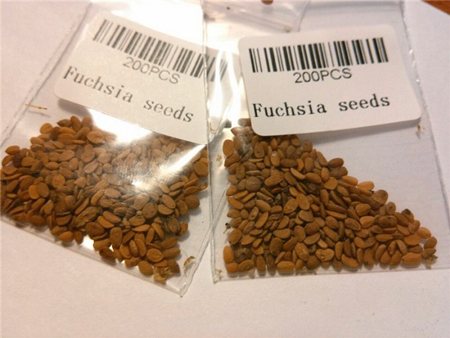

After pollination, a bag is put on the bud, which is tightened with a thread or twine.
This is a protection against foreign pollen grains and the loss of ripe seeds.
At home, this measure can be neglected, but if the plant is in the open air, fruits with seeds can become prey for birds or a gust of wind.
Pouches can be:
- gauze;
- paper;
- made of non-woven covering material.
The latter option is preferable when fuchsia is placed in open ground (for example, cold-resistant varieties "Ricartona" and "Fuchsia graceful").
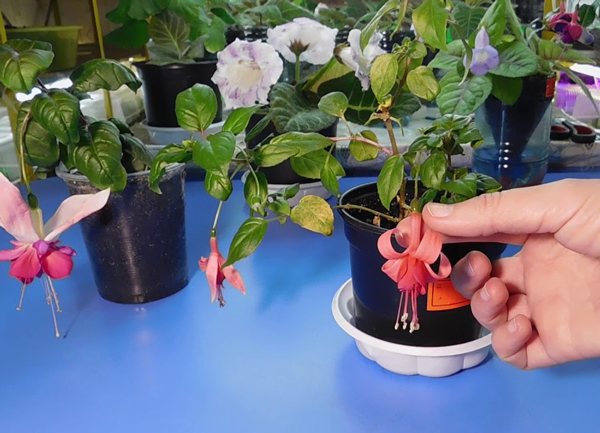

Overheating is possible in paper bags, and gauze sticks together when wet. Dark soft fruits will ripen in a few weeks. Then the bags are removed and the fruits are cut.
Caution! It is necessary to remove fuchsia seeds from the fruit carefully so as not to damage the seed.
The resulting seeds are dried for several days. This prevents rotting and improves germination. Once dried, the seeds can be planted or stored.
Features of rooting by cuttings
Many flower lovers root fuchsia with cuttings - it is the simplest and most reliable... In addition, plants can be rooted at any time of the year, but the most optimal period is spring, when the seedlings have a lot of vitality. There are several ways:
- prepare the ground and plant a stalk in it;
- put a young plant in water, and wait for the roots to appear;
- apply vermiculite, perlite or moss for rooting.
Attention: The basic rule for fast rooting is good, light soil mixture, moisture, optimal temperature and greenhouse effect.
Fuchsia in the garden and in the house
According to the biological description, fuchsia is a small, compact tree with flexible shoots of a reddish hue, medium-sized lancet-shaped leaves, green or red, and numerous flowers of various shades and types.
Fuchsia flowers consist of two parts: a bowl and a tubular corolla, under which there are bright long stamens. Often the corolla and calyx of the flower have different shades. And outwardly, these inflorescences are very reminiscent of miniature dancers in graceful fluffy or flowing skirts.
This plant has a very long flowering period. With proper care, it can last from early spring to almost winter. This made fuchsia very attractive to growers. For three centuries, during which active selection of this flower was carried out, a huge number of plant varieties were bred. Among them there are fuchsias of various types, including erect and ampelous, larger and more compact, as well as very spectacular varieties with flowering shoots collected in racemes, etc.Fuchsia is an excellent decoration for windows, winter gardens and loggias. In addition, during the summer period it can be placed on outdoor terraces and in the garden. How Dahlia is grown can be understood by reading this article.
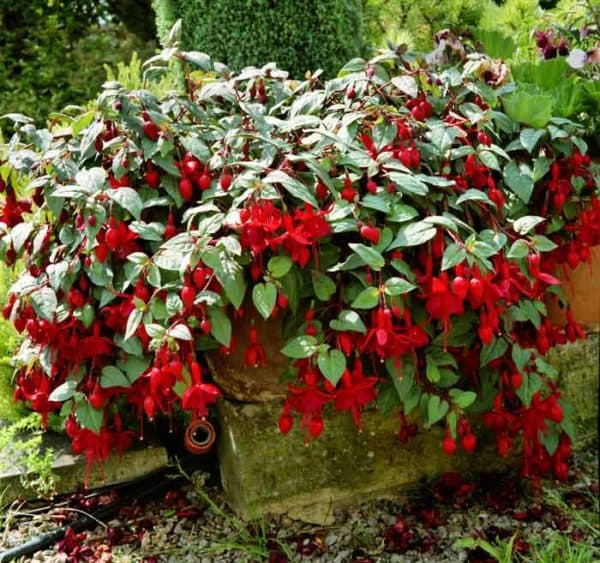

Description of fuchsia
Fuchsia can be in the form of a shrub, ampelous houseplant, or a small tree. It has beautiful flexible branches that grow in a flowing direction. The leaves are bright green, oval, pointed and up to 5 cm long.
The color of the flowers can be quite different - white, pink, blue, purple. Many of them are shaped like a bell, and some remind flower growers of ballerinas in dance. This is due to the special structure of the flower. So, the tubular corolla is the start of the opening of soft petals with a fluffy skirt, reminiscent of a dancer's tutu. Stamens of great length, which look out further - like the slender legs of a ballerina in pointe shoes.
Planting seeds
Before planting fuchsia, the soil must be well tamped. Seeds germinate in good light. If the ground is loose, the seed will fall into the ground and hatch with a delay.
Anyone who has seen what the seeds look like knows that they are relatively large, they are easy to plant one at a time. In the soil, you need to make depressions no more than half a centimeter. Place a seed in each hole. You don't need to sprinkle it with earth.
Distance between holes in a landing container about seven centimeters... However, this is not necessary. Many plant seeds very densely, and when the first true leaf appears, they make a dive - they place each bush in a separate cup.
Another common planting option is one seed each in a peat pot, in special cells for seedlings or in egg containers.


Further, it is necessary to ensure the germination temperature from 23 to 26 degrees. This is not difficult if you cover the container with a transparent lid, glass or foil.
In addition to light and heat, air is needed for germination, therefore obligatory daily airing.
Soil moisture should be moderate: waterlogging is harmful as well as drying. When the seeds germinate, the cover must be removed from the container. At the same time, it is necessary to continue to monitor daily so that watering is not excessive or scarce.
This video discusses the main mistakes that beginner growers make in fuchsia cultivation:
Flower diseases and methods of their treatment
Care for fuchsia can be as correct and successful as you like, but no one is immune from diseases. Fortunately for those who love these plants, they rarely get sick.
For example, fuchsia does not tolerate stagnant air. The room must be abundantly ventilated; but drafts must not be allowed.
It often happens that fuchsia ends flowering too quickly. In this case, you need to remember what the care for fuchsia was like before. A quick cessation of flowering is possible after too much watering, and after insufficient; it also occurs as a result of too warm wintering, because the dormant period is the time when the plant lays buds. The rapid end of flowering is also possible due to a lack of sunlight.
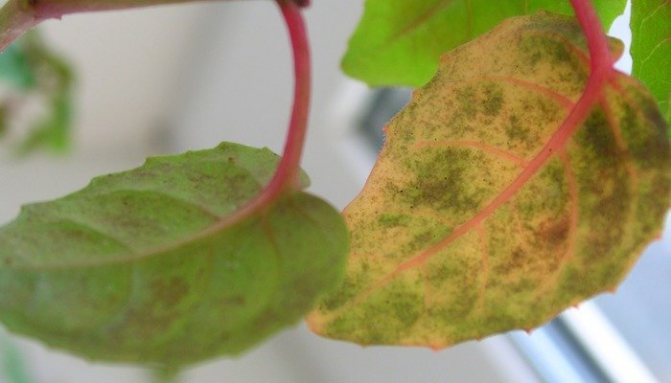

Too bright light in winter is also not very good. In this case, the fuchsia begins to shed its leaves. To combat this scourge, it is enough to rearrange the pot to a more shaded place. It happens that in winter buds appear in fuchsia; they must be cut off, since the plant does not have enough strength for winter flowering. At other times, leaf fall may be associated with low air humidity.
These mistakes in fuchsia care can provoke buds and flowers to fall off. With a lack of sunlight, fuchsias are strongly stretched in length, while not wanting to release flowers.
The appearance of the bush can tell a lot about the health of the bush; in particular - the appearance of the roots. Normally, they should be white, hard and resilient.If the roots are noted to have become brown and soft, then this means that they have begun to rot. To save fuchsia, all rotten root areas must be cut out down to healthy parts. Of course, after this, the plant will regain its shape for some time and grow new roots, but it will remain alive.
The stems of a healthy fuchsia are also noticeably different from the diseased one. Any plant affected by anything loses its luster and attractiveness, becomes lethargic and lifeless in appearance. In this case, it will also be useful to remove the plant from the pot and look at the roots - it may turn out that the reason for the wilting is precisely in them.
Fuchsias and pests are affected. One of the most common are spider mites. This is a real scourge of indoor plants, eating leaves - one of the main treasures of fuchsias. The ticks themselves are very small and difficult to deal with.
Another common pest is the whitefly. This small butterfly lays eggs on the underside of the leaves, from which the larvae later hatch, feeding on these leaves. Due to the miniature size of these butterflies, many plant owners do not notice the appearance of the first individuals or do not attach particular importance to them; however, later, when whiteflies begin to fly over the plant in whole flocks, it will be quite difficult to fight them. The harm from the larvae of these butterflies is not only that they feed on plant juices, but also that they secrete a sticky liquid, on which fungi can subsequently develop. Whitefly control methods are quite diverse: this is mechanical removal - washing off the larvae with water or soapy water; and the use of insecticides; and the use of a tobacco checker. One of the most unusual ways to deal with these butterflies is using yellow glue traps: researchers have found that whiteflies are attracted to yellow.
When buying fuchsias in a store or "by hand", certain problems may arise. Therefore, it is necessary to purchase plants from reliable sources. When purchasing a store plant, you need to make sure that it is planted correctly, without roots protruding from the ground, does not have dark and rusty spots, and looks healthy; there should be no signs of pest infestation on the plant. A tag should be attached to the plant indicating the type and variety, as well as the shape of the plant (ampelous, bush or standard), and there should be a photograph of flowers on it.
Features of flower propagation by cuttings
In early summer, cut the cuttings with 3 paired leaves. You need to cut with a sharp blade at an oblique angle. The stalk can be placed in a container of water or in loose soil. It is useful to cover the cuttings with glass or plastic. The containers must be ventilated daily, and the soil must be moistened.


The best time for cuttings is spring.
The roots will appear in 2 weeks, they can be planted when the length of the roots is 2 cm. The stalk, which has given roots in water, is transplanted into a pot with loose soil.
How to care for young plants
Rooting takes place within three or five days... Picking is stressful for seedlings, so now they need more attentive care.
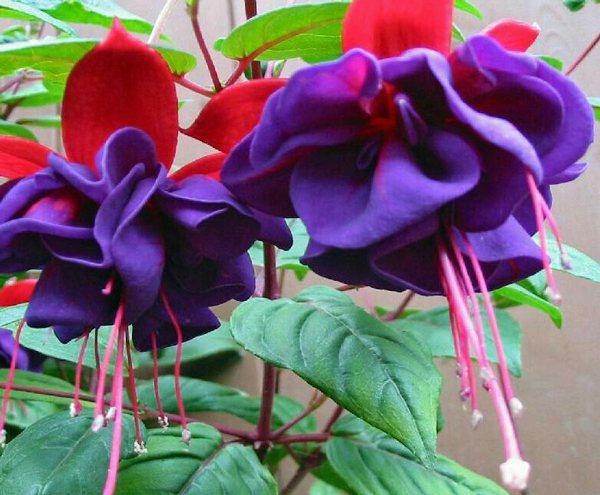

Direct sunlight is harmful to them, but a lot of light is required. Drafts and cold air are detrimental to the seedlings. Excessive watering is harmful; there should be no dry crust on the surface either.
The first feeding is possible not earlier than twelve days. Complex mineral fertilizer is quite suitable for this. To prevent over-stretching of the stem, you can use the "Athlete" - the stem becomes thicker and stronger.
What is fuchsia?
Description of the flower
The leaves of the flower have a juicy green color, sometimes with a reddish tint, oval in shape with pointed ends.
Flowers are arranged in groups or singly. The flowers are drooping, have the shape of a bell from which the stamens and pistil hang. With proper care, fuchsia can bloom all year round.
Flowers are varied: double, semi-double and simple. The color surprises with its beauty: red, lilac, white, purple, can be two-color, and sometimes three-color. After flowering, a berry fruit is formed, which can be eaten. The fruits of this flower are used in the manufacture of jam.
Perhaps it is useful for everyone to knowhow to propagate geranium by cuttings.
Varieties
- Hybrid... Cultured hybrid. Has double and semi-double flowers passers-by on bells. Ideal for indoor growing.
- Ampelnaya. These flowers are bred for growing in hanging pots. The shoots of such plants stretch upward, like those of climbing plants. They are ideal for decorating balconies, curbs and flower beds.
It is necessary to select a variety taking into account the microclimate and lighting.
Basic rules of care
The plant is relatively unpretentious, but you need to care for fuchsia carefully, remembering all the rules and prohibitions.
Pot selection
It is advisable to choose a ceramic pot... In a plastic pot, the plant will be hot in summer, and it is better to take care of this in advance, protecting the roots from excessive heat entering them.
The size of the pot should be directly related to the size of the root crop. It is better to transplant the plant several times than to plant fuchsia in an oversized pot. This is due to the fact that the soil, which has not been reclaimed by the roots, can begin to acidify, which often entails rotting of the roots.
The presence of drainage holes is one of the main criteria for choosing a pot. Fuchsias do not tolerate stagnant water.
Some lovers of this flower use pieces of charcoal as drainage.
Required soil composition
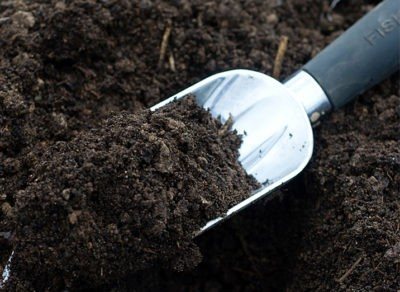

Fuchsia requires light soil with good drainage and a neutral reaction.... It is best to mix the soil yourself in the right proportions, thereby protecting the plant from harmful elements that can get into the universal soil.
- The best option is peat, compost and leaf humus, mixed in the same volume with the addition of double the volume of sand.
- You can also mix turf, leaf humus, and ash in a 5: 2: 2 ratio. In this variant, humus can be replaced with granular peat.
Both of these options work well as a homemade potting soil mixture and serve as a nutritious and moisturizing soil for growing fuchsia.
How to correctly form the humidity level?
The plant needs to form and maintain a moisture level that is about 60-70%. An exception is the dormant period, which occurs in winter. For spraying, it is advisable to use a bottle with settled water and a spray bottle. There are several rules for proper hydration:
- the water should be warm;
- it is necessary to spray twice a day;
- if several fuchsias grow in the flower garden, it is not necessary to use a spray bottle - it is better to take a small bowl, fill it with pebbles and fill it with water.
Lighting
It is necessary to provide the plant with good lighting by exposing it to windows that are not on the sunny side, for example, on a balcony, whose windows face west or east.
In dark rooms, fuchsia blooms may worsen, however, the green mass is developing quite well. Therefore, in order for the flower to grow well, it is better to expose it to the light on sunny days, but put it in a darker place at noon. It is acceptable to use blinds on the windows or other thick curtains that provide good shade.
Temperature regime
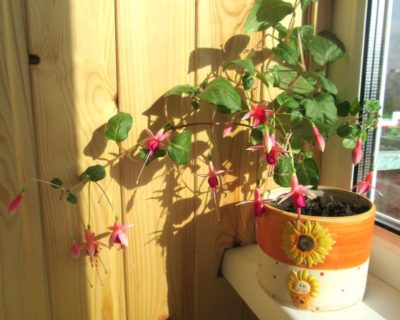

Before growing a plant, it must be remembered that fuchsia roots love a cool temperature, so it is better that the flower is not in a room with an air temperature of 30 ° C, as this can lead to death.
- In summer, the temperature should be between +18 and +24 ° C.
For cooling, it is best to use sun protection and good fresh air flow. This is another reason why a balcony can become a place for a flower to "live". - The temperature in winter should not exceed + 5 ... + 12 ° С.
Watering
A dry earthen lump will indicate the need for watering.
- In summer, the flower should be watered at least 2 times a week, in autumn and spring - once every 1-2 weeks.
- In winter, the frequency of watering should be reduced to 1 time per month (for details on how to properly prepare fuchsia for wintering and how to keep it in the basement and in the cellar, read here).
You need to water the flower with settled water, the temperature of which is not higher or lower than room temperature.
Pests and the fight against them
Fungal diseases affect fuchsia only with serious violations of agricultural technology: excessive watering or spraying at low air temperatures, stagnant water in the pan. If signs are found, the plant is treated with systemic fungicides, and watering is reduced.
In the summer period, such pests as spider mites or whiteflies are happy to settle on "gypsy earrings". In the first case, young leaves begin to shrink and become covered with a thin cobweb. To solve the problem, 3-4 treatments with any acaricide with an interval of a week are enough.


Whitefly
The greenhouse whitefly - and this is the variety that most often affects fuchsias - is more difficult to cope with. Insects actively reproduce, and their larvae are reliably protected from the penetration of poisons. Therefore, you can get rid of the whitefly only by "poisoning" the plant itself, so that the larvae die as soon as they start feeding. For this purpose, systemic insecticides are used, such as Fufanon, Aktara. 6-7 treatments are carried out with an interval of three days.
Whiteflies hide on the wrong side of the leaf, preferably on the upper shoots, and reproduce quickly. In the fight, take off you need to water and spray the plant with Aktara's solution. To do this, dissolve 1 g of the drug in 1 liter of water.
Spider mite
This happens on hot, dry days. The leaves of the plant turn yellow and dry; a thin cobweb is visible on the inside of the leaf. To kill the tick, you need to spray the leaves with a solution of Akarin or Fitoverm.
General information
Indoor fuchsia (fuchsia) is a perennial plant belonging to the Cyprian or Donkey family. Natural distribution area - New Zealand, Chile, Central and South America. It was first cultivated in England at the end of the 18th century and has since gained worldwide popularity. On the basis of more than 100 natural species, many hybrids have been bred with flowers of various shapes and colors. The plant is popularly called "gypsy earrings".
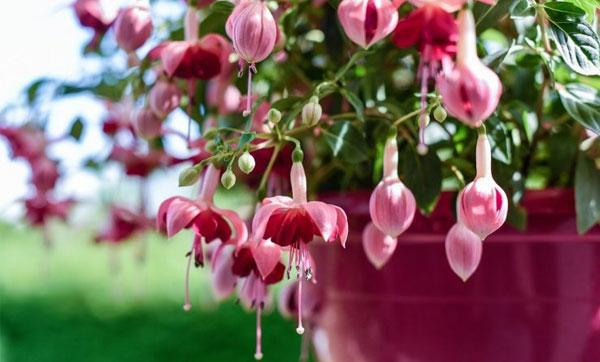

Fuchsia is an evergreen tree-like shrub. Leaves no longer than 5 cm, green, sometimes reddish, ovoid or oval, with small denticles and prominent veins. Located opposite. Fuchsia flowers are solitary, drooping, formed in the axils. They consist of four bent sepals and a bell-shaped corolla. The latter is affectionately referred to by flower growers as a "skirt", from under which the stamens with a pistil hang, completing the resemblance to a ballerina in a lush tutu. After pollination, an edible berry is formed.
Indoor plant - fuchsia
The homeland of all types of fuchsia flower is Central and South America, as well as New Zealand. Fuchsias are evergreen shrubs. They gained particular popularity because of the unusual shape of their flowers. Their petals are much smaller in size than the leaves of the corolla calyx and stamens, due to which the flower takes on a "bristling" appearance. In color theory, "fuchsia" is usually called a light pink-violet shade; but the flowers of real fuchsia can have different colors, up to black and dark blue. After flowering, berry-like fruits appear that can be eaten. Among fuchsias, there are both small trees and ampelous plants.
There is also a chemical compound called "fuchsin", also named after this plant; its aqueous solution has a purple-red color, similar to the flowers of many fuchsia species.
The history of the discovery and study of these plants is quite romantic.She is associated with the famous French botanist of the 17th century Charles Plumier, who took part in a grand expedition to the West Indies and was the discoverer of many new plants. Among them were fuchsias, which he named after Leonard von Fuchs, a German scientist of the 16th century who is considered the pioneer of botany as such. In the next, eighteenth century, this name was used by Karl Linnaeus, the great Swedish scientist who officially introduced modern nomenclature into biology; that is why Linnaeus is considered the author of the botanical name of the genus Fuchsia, and not Plumier.
There are, however, alternative versions of the discovery of this flower. According to one of them, when Plumier brought this plant to Europe, their relatives were already decorating one of the botanical gardens in England, where they were brought by George Handisid from the shores of the Strait of Magellan. Another version claims that Leonard von Fuchs himself was the discoverer of fuchsia. Another legend says that fuchsia was brought to the "old world" by the Spanish conquistadors, who presented it to their king.
At one time, fuchsias were extremely popular all over the world. They were bred in wealthy houses. Fuchsias were featured in one of the world's first color photographs, taken in 1912; apparently, the author reasonably considered that such a bright plant should not be photographed in the traditional way, giving only a black and white image.
Due to the popularity of fuchsia as a houseplant, breeders have developed many artificial varieties of these plants. In addition, a popular folk name for the fuchsia flower has appeared - "gypsy earrings", apparently indicating the characteristic shape of the flowers of this plant. Other names are also known - for example, "flower of the elves". Due to the fact that the shape of the flowers resembles a ballerina in a pack, the plant also received the popular name "ballerina".
Apparently, an interesting legend about the origin of this flower is associated with the last name. She says that in the distant past there were seven sisters who were famous for their beauty; they also knew how to dance beautifully, so much so that all nature froze, admiring their art. An evil wizard who lived in foreign lands learned about this. He wanted to take all the sisters to him, one of whom would become his wife, and all the others - concubines. The sisters categorically refused, and the vexed sorcerer turned them into fuchsias - plants that remind of their dances in their appearance.
Fuchsia at home is represented by some especially popular species and varieties: graceful fuchsia, shiny fuchsia, bolivian fuchsia, etc. Some of them have flowers arranged singly, while others, like magellan fuchsia, are collected in inflorescences.
There are many different signs associated with fuchsias. So, it is believed that they awaken creative energy, so they need to be turned on by creative people. Fuchsia also helps to find a way out of a difficult situation, to solve some difficult problem. It develops intuition and strengthens positive energy in the house, protects the room from the penetration of foreign energy. It is also believed that fuchsia somehow helps to cure people suffering from diseases of the digestive system, breast and thyroid gland.
But the most common belief is that girls and married women should not have fuchsias in the house; for this plant is called the "widow's flower" or "widow's tears." However, despite the wide popularity, women do not pay attention to this belief and are happy to have fuchsias in their apartments.
Digressing from signs and superstitions, it is worth mentioning the relatives of fuchsias. Among them there are fairly well-known plants such as clarkia, evening primrose, as well as fireweed and ivan tea. The last two genera (sometimes combined into one) have been known in Russia for a long time - in fact, as "tea" plants. Traditional Koporye tea was prepared from them.It is noteworthy that in Orthodox monasteries, a tea drink from this relative of fuchsia was used as a substitute for traditional Chinese tea, which, due to its stimulating effect, was prohibited for monks. And the residents of the Russian North have long used the stems of fireweed as a snack.
By the way, fuchsia itself is also edible - absolutely all parts. Therefore, this plant is one of the most convenient for growing in those homes where there are children who like to drag anything into their mouths. Most often, however, fuchsia berries, which have a sweet and slightly tart taste, are eaten. In our country, it is hardly possible to get a large harvest of these fruits in an apartment environment, therefore they are used as an effective addition to dishes and desserts. But in countries where fuchsias grow in nature, large harvests of these berries are regularly harvested; they are eaten fresh, jam is made from them. In particular, these fruits are popular in Haiti. The Indians made wine from fuchsia berries. There is information that fuchsia fruits also have a certain healing effect.
As for the leaves of fuchsia, they are similar in different species - they have a rounded or oval shape; but the edges of the leaves differ in different species and varieties - they can be smooth, wavy, and even with pointed teeth. In natural species, the color of the leaves is always the same - deep green; however, varieties with other shades of leaves, including variegated colors, were artificially bred.


